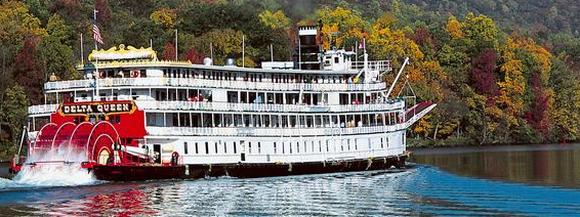 On the same day that I heard the news of the horrific fire on the dive boat Conception which killed 34 passengers and crew, I also saw an article attacking the safety waivers granted to the riverboat Delta Queen. It raised the question, do the Delta Queen fire safety exemptions make too many compromises? Should the old riverboat be allowed to operate without fully meeting the current regs? On the other hand, the dive boat Conception and boats like her, met and meet all the current regulations, and still, the Conception turned out to be a death trap.
On the same day that I heard the news of the horrific fire on the dive boat Conception which killed 34 passengers and crew, I also saw an article attacking the safety waivers granted to the riverboat Delta Queen. It raised the question, do the Delta Queen fire safety exemptions make too many compromises? Should the old riverboat be allowed to operate without fully meeting the current regs? On the other hand, the dive boat Conception and boats like her, met and meet all the current regulations, and still, the Conception turned out to be a death trap.
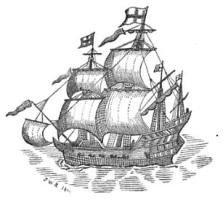 Here is a wholly random question. When and where was William Shakespeare’s tragedy Hamlet first performed on shipboard?
Here is a wholly random question. When and where was William Shakespeare’s tragedy Hamlet first performed on shipboard?
The first recorded shipboard performance of Hamlet, and one of the earlier performances anywhere, was in September 1607 on the East India Company ship, Red Dragon under the command of Captain William Keeling on a voyage to the Spice Islands. The ship was anchored off Sierra Leone to allow the crew to recover from a serious outbreak of scurvy. Captain Keeling was an enthusiastic follower of Shakespeare’s plays. From Shakespeare’s World:
During their recovery, the captain put his crew on a diet of citrus fruits and allowed performances of Shakespeare’s plays for entertainment. Earlier in September 1607. Hamlet was performed aboard the Red Dragon. Keeling recorded in his diary: Continue reading
 In May of last year, we posted about the Russians’ first floating nuclear power plant, “Akademik Lomonosov — Floating Chernobyl or Nuclear Titanic?.” At the time, the barge-mounted power plant was essentially completed but needed to be loaded with fuel. Now the reactor, capable of generating 70 Megawatts of power, is being towed to the Arctic, a more than 3,000-mile voyage.
In May of last year, we posted about the Russians’ first floating nuclear power plant, “Akademik Lomonosov — Floating Chernobyl or Nuclear Titanic?.” At the time, the barge-mounted power plant was essentially completed but needed to be loaded with fuel. Now the reactor, capable of generating 70 Megawatts of power, is being towed to the Arctic, a more than 3,000-mile voyage.
As we posted previously, once operational, the plant will be connected to the electrical grid in the Arctic town of Pevek. It will be the world’s northernmost nuclear reactor, capable of powering a town of 100,000 people. The reactor barge will be anchored at the Kamchatka Peninsula in the Arctic, northwest of Russia. The almost 500-foot long Akademik Lomonosov has a displacement of around 21,500 tons.
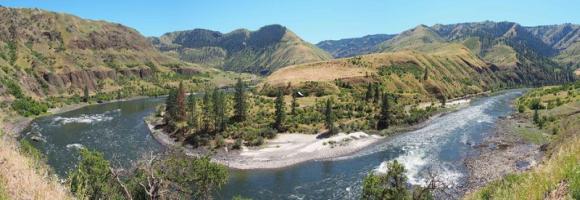
Cooper’s Ferry, Idaho Photo: Loren Davis, Oregon State University
More evidence that the first travelers to the Americas may have been sailors.
The classic theory of the arrival of early people in North America was the Clovis model. The theory was that early humans migrated to North America by walking over an Alaskan landbridge from Asia around 13,000 years ago. Roughly 14,000 years ago, the landbridge became passible due to the retreat of ice due to rising temperatures.
Now, a team of archeologists working in Cooper’s Ferry, Idaho have uncovered artifacts dating back to 16,000 years ago, well before the landbridge was clear of ice. Whomever these early humans were, they did not walk from Asia. They most likely arrived by boat. Evidence suggests that glaciers retreated from the Pacific coast around 17,000 years ago which would have allowed early Asian sailors to make their way up the Columba River valley to Cooper’s Ferry.

Pacific pumice raft
Back in 2012, we posted about a series of photos that were floating around the internet. The photos were taken from a yacht that had encountered what appeared to be a beach, stretching as far as the eye could see in the middle of the South Pacific. It turned out that what they were seeing was floating pumice, the volcanic rock formed when lava erupts underwater. With a bit more investigation, it appeared that the photos dated back to 2006. At around the same time, the New Zealand Navy reported a pumice raft covering an area of roughly 10,000 square miles.
Recently, the New York Times reported that a couple sailing in the Southwest Pacific encountered a similar pumice raft — a floating mass of volcanic rocks, with some boulders as large as basketballs, blanketing the ocean as far as their boat’s spotlight could illuminate.
 Imagine a yacht that is almost completely silent, with a close to unlimited range, and that doesn’t pollute. While it may sound too good to be true, this is what Silent Yachts is aiming for in its line of electrically-powered luxury catamarans. The company offers catamarans ranging from 44 to 80 feet long and recently upgraded and improved its Silent 55 design. One of the new designs has been delivered and three more are on order.
Imagine a yacht that is almost completely silent, with a close to unlimited range, and that doesn’t pollute. While it may sound too good to be true, this is what Silent Yachts is aiming for in its line of electrically-powered luxury catamarans. The company offers catamarans ranging from 44 to 80 feet long and recently upgraded and improved its Silent 55 design. One of the new designs has been delivered and three more are on order.
 I recently came across a reference for a “nocturnal for both bears.” It sounded, at first, like a piece of music written by Mussorgsky or perhaps Prokofiev, which it isn’t. It is a device used for telling time at night by the position of Polaris and the stars of the constellation Ursa Major, the “big bear.”
I recently came across a reference for a “nocturnal for both bears.” It sounded, at first, like a piece of music written by Mussorgsky or perhaps Prokofiev, which it isn’t. It is a device used for telling time at night by the position of Polaris and the stars of the constellation Ursa Major, the “big bear.”
The instrument, known in English as a noctural and in French as a nocturlabe, is essentially an astroble to be used at night. As the pole star, Polaris, is in the constellation Ursa Minor, the “little bear” and the device involves sighting the stars from both big and little bears, the device is a “nocturnal for both bears.” It was first developed in the 1500s and was used up into the 18th century. As a device used for telling time at night, it was apparently only accurate to within 15 minutes or so.
Here is a fun “superlapse” video of last weekend’s Gloucester Schooner Festival Parade of Sail.
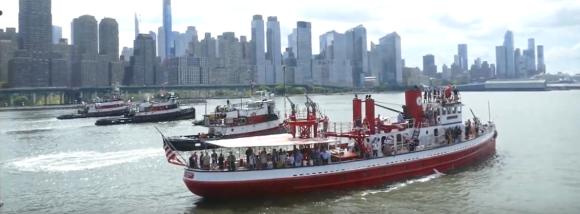
I was away for the 27th Annual Great North River Tugboat Race last weekend so I am grateful for this wonderful video from Youtube shot from the winning tug, Vinik No. 6, in an exciting race on a beautiful Sunday on the Hudson River.
Riding tugboat Vinik No. 6 to victory in the 27th annual Great North River Tugboat Race
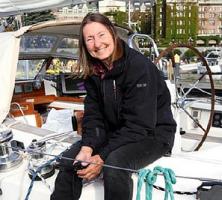 For the last several days, Jeanne Socrates has been within sight of the mountains of the Vancouver coast, tantalizingly close to completing her 4th circumnavigation, and, at 77, becoming the oldest person to sail around the world solo, unassisted and non-stop.
For the last several days, Jeanne Socrates has been within sight of the mountains of the Vancouver coast, tantalizingly close to completing her 4th circumnavigation, and, at 77, becoming the oldest person to sail around the world solo, unassisted and non-stop.
Just 20 nautical miles from the entrance of the Strait of Juan De Fuca, and less than 80 miles from her destination in Victoria, British, Columbia, she has been set back by contrary currents and a lack of wind. Weather forecasts suggest a northwesterly wind later today may yet allow her to make landfall in Victoria this evening.
She set sail from Victoria on October 3, 2018, on her 38′ long S/V Nereida, a Najad 380, and should return back to the dock in Victoria today, after roughly 340 days at sea. At the age of 77, she now holds the record for the oldest person to sail around the world solo, non-stop and unassisted.
Jeanne Socrates is a grandmother of three, originally from Ealing, West London. She didn’t start sailing until she was 50. Prior to her most recent voyage around the world, she held the record as the oldest female to have circumnavigated the world single-handed, and the only woman to have circumnavigated solo nonstop from N. America. She was awarded the Cruising Club of America’s Blue Water Medal in 2013.
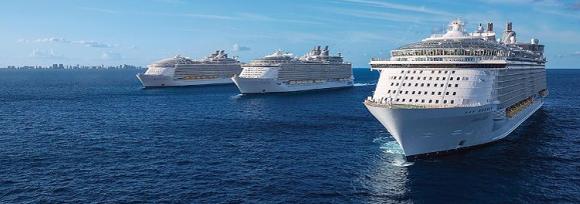 The cruise industry in the Caribbean is donating to help the Bahamian victims of Hurricane Dorian. Royal Caribbean, Carnival, Norwegian Caribbean and Disney have all pledged millions in hurricane relief.
The cruise industry in the Caribbean is donating to help the Bahamian victims of Hurricane Dorian. Royal Caribbean, Carnival, Norwegian Caribbean and Disney have all pledged millions in hurricane relief.
Royal Caribbean is committing $1 million to Dorian disaster relief, and ITM— a partner in real estate development—is also donating an additional $100,000. RCL is also matching donations from guests and employees through their charity partner Pan American Development Foundation (PADF).
Royal Caribbean also announced that it plans to stock its ships with goods, including generators, water, cleaning supplies, sheets and towels, for delivery to the Bahamas.
Carnival Cruise Line’s corporate parent and its chairman on Wednesday pledged a total of $2 million toward hurricane-relief efforts in the islands.
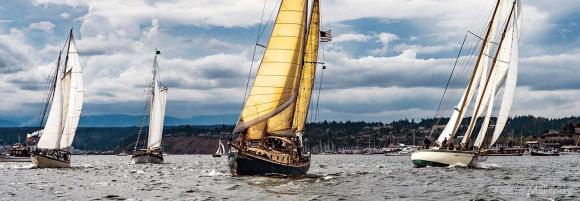 The 43rd Annual Wooden Boat Festival in Port Townsend, WA, starts this Friday and runs through the weekend, September 6-8, 2019. It is billed as the largest wooden boat festival in North America and promises to be a place where kids and adults alike can experience the magic of getting on the water, the beauty of wooden boats, and the richness of our maritime culture.
The 43rd Annual Wooden Boat Festival in Port Townsend, WA, starts this Friday and runs through the weekend, September 6-8, 2019. It is billed as the largest wooden boat festival in North America and promises to be a place where kids and adults alike can experience the magic of getting on the water, the beauty of wooden boats, and the richness of our maritime culture.
The festival is described as the most education-packed and beautifully located wooden boat event in the world. Featuring more than 200 wooden vessels, hundreds of indoor and outdoor presentations and demonstrations, a who’s who of wooden boat experts and thousands of wooden boat enthusiasts, there’s something to do, someone to meet, or a boat to board at every turn. Expanded a little each year, the Festival honors its traditions while inviting energetic debate about the latest innovation. Check out their website or WBF Facebook page for the most recent 2019 info.
Thanks to Virginia Jones for contributing to this post.
 A horrific fire broke on the commercial scuba diving vessel, Conception, off Santa Cruz Island in the Channel Islands of California, early on Monday morning. Thirty-four people are believed to have died in the fire. Five of six crew members escaped alive. So far, the Coast Guard has recovered 25 bodies from the hull of the wooden dive boat. Nine remain missing and are presumed dead. Most of the dead were asleep in a common bunk room below deck when the intense fire broke out.
A horrific fire broke on the commercial scuba diving vessel, Conception, off Santa Cruz Island in the Channel Islands of California, early on Monday morning. Thirty-four people are believed to have died in the fire. Five of six crew members escaped alive. So far, the Coast Guard has recovered 25 bodies from the hull of the wooden dive boat. Nine remain missing and are presumed dead. Most of the dead were asleep in a common bunk room below deck when the intense fire broke out.
A Mayday call reporting the fire was received at 3:15 AM, Monday morning. The fire is started on the 75′ long wooden dive boat while it was anchored about 20 yards off Platts Harbor on Santa Cruz Island, officials said. Firefighters were attempting to put out the fire when the boat sank in 60-foot waters. The dive boat was on a three-day dive excursion.
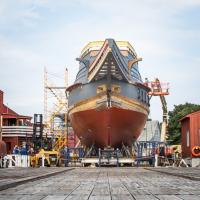 On September 7th at 2PM, the Plimoth Plantation‘s Mayflower II will be launched and recommissioned at Mystic Seaport Museum. The replica of the ship which carried the Pilgrims to Plymouth, MA has undergone a major three-year restoration at the seaport’s Henry B. duPont Preservation Shipyard. In preparation for launching, the ship will be christened with water from all 50 states as well as Plymouth, U.K., and Leiden, Netherlands. Once the Mayflower II returns to Massachusetts in spring 2020, the ship will be the centerpiece of the 400th commemoration of the Pilgrims’ arrival to historic Patuxet, now known as Plymouth.
On September 7th at 2PM, the Plimoth Plantation‘s Mayflower II will be launched and recommissioned at Mystic Seaport Museum. The replica of the ship which carried the Pilgrims to Plymouth, MA has undergone a major three-year restoration at the seaport’s Henry B. duPont Preservation Shipyard. In preparation for launching, the ship will be christened with water from all 50 states as well as Plymouth, U.K., and Leiden, Netherlands. Once the Mayflower II returns to Massachusetts in spring 2020, the ship will be the centerpiece of the 400th commemoration of the Pilgrims’ arrival to historic Patuxet, now known as Plymouth.
From the Mystic Seaport website:
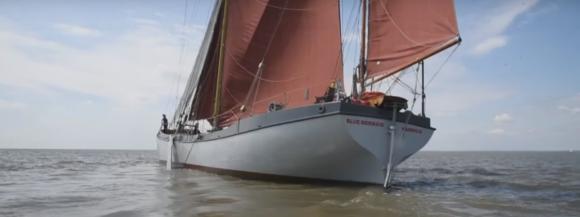
Classic Sailor reports on a new Thames sailing barge: A new sailing barge is a rare sight – but in 1900 there were around 4,000 such barges registered to carry cargo up and down the London river – and the surrounding coasts, using just the wind and the tide. And mostly with a crew of just two…
And the Blue Mermaid has also been built for trade… in fact, she’s the first sailing barge built for trade in Britain since 1930. She’s 87ft long and has a hold that can carry 84 pallettes or 150 tons of loose cargo – that’s The equivalent of Five articulated lorry loads.
She has a couple of cabins aft for skipper and mate and bunks forward for five or six more crew – plus the hold can be used when it’s empty.
She was built at Toms shipyard in Polruan near Fowey in Cornwall. And launched from there as a bare hull in 2016. She was towed around the coast, to the home of sailing barges in Maldon where she was fitted out at the Downs Road Boatyard. Continue reading
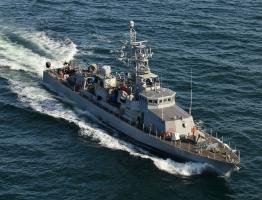
USS Shamal
The US Navy is sending six ships from the Naval Station Mayport in Jacksonville, Florida into the Atlantic in an attempt to get out of the path of Hurricane Dorian, which is expected to strengthen to a category 3 and possibly a Category 4 hurricane before making landfall in Florida.
The patrol ship USS Shamal (PC 13) got underway on Thursday, and the destroyers USS Lassen (DDG 82), USS Paul Ignatius (DDG 117), USS Farragut (DDG 99) as well as the Littoral Combat Ships USS Billings (LCS 15), and USS Milwaukee (LCS 15), got underway from NS Mayport on Friday.
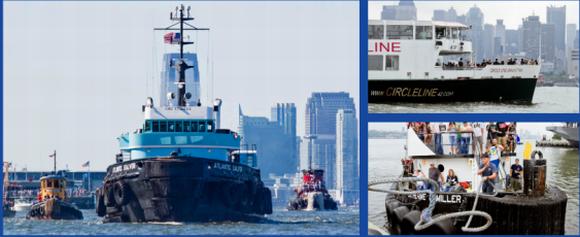
Photos: Mitch Waxman
The 27th Annual Great North River Tugboat Race, sponsored by the Working Harbor Committee, will be held on the Hudson River near Pier 84 starting at 11 a.m. on September 1st. Watch from shore or get onboard the Spectator Boat and see the whole event up-close. Boarding begins at 10:15 am, departure is at 10:30 am from Pier 83. Tickets for the Spectator Boat cost $25 for adults, $20 for seniors and $12 for kids, 3-12. Click here to buy tickets.
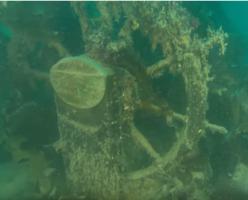 Recent video of the extremely well-preserved wreck of Franklin’s ship Terror may shed new light on the many mysteries of Franklin’s lost expedition.
Recent video of the extremely well-preserved wreck of Franklin’s ship Terror may shed new light on the many mysteries of Franklin’s lost expedition.
In 1845, Captain Sir John Franklin departed England in command of two specially outfitted ships, Erebus and Terror. He was leading an Arctic expedition, intending to traverse the last unnavigated section of the Northwest Passage. Instead, the expedition of 139 simply disappeared. Numerous attempts were made to find and rescue Franklin and his party, but to no avail.
The wrecks of the Erebus and Terror were not located until almost 170 years later. The Erebus was found in 2014, south of King William Island in northern Canada. The Terror was found two years later close-by in, appropriately and coincidentally enough, Terror Bay Continue reading
 Accompanied by a flotilla of well-wishers, 16-year-old Swedish climate activist, Greta Thunberg, sailed into New York harbor today on the foiling monohull IMOCA 60, Malizia II. Greta is on her way to UN climate talks being held in September. To avoid the carbon footprint of flying, the young activist chose to sail across the Atlantic on the racing yacht, which has an almost zero carbon footprint. She set sail from Plymouth, England on August 14th.
Accompanied by a flotilla of well-wishers, 16-year-old Swedish climate activist, Greta Thunberg, sailed into New York harbor today on the foiling monohull IMOCA 60, Malizia II. Greta is on her way to UN climate talks being held in September. To avoid the carbon footprint of flying, the young activist chose to sail across the Atlantic on the racing yacht, which has an almost zero carbon footprint. She set sail from Plymouth, England on August 14th.
One might quibble about the choice of means of transportation or even suggest carbon offsets to counter the footprint of the air flight. Nevertheless, it is hard not to admire this teenager’s spirit and the example that she sets.
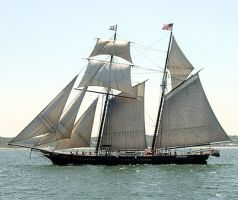 I feel like beginning this post with the old cheer, “The King is dead! Long live the King!” But no. That is hardly apt. How about “the schooner Shenandoah is for Sale! Long Live Shenandoah 2.0!” That still is not quite right, but it is closer. Here is the story.
I feel like beginning this post with the old cheer, “The King is dead! Long live the King!” But no. That is hardly apt. How about “the schooner Shenandoah is for Sale! Long Live Shenandoah 2.0!” That still is not quite right, but it is closer. Here is the story.
Toward the end of May, an advertisement published in Boats and Harbors and then picked up on Facebook by Marlinspike Magazine, said the schooner Shenandoah was for sale for $850,000.
